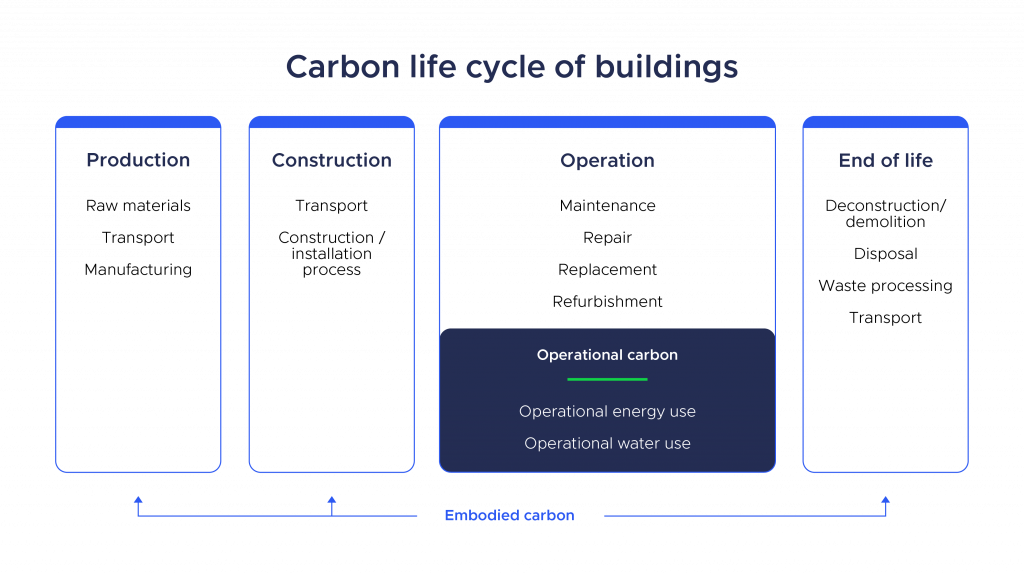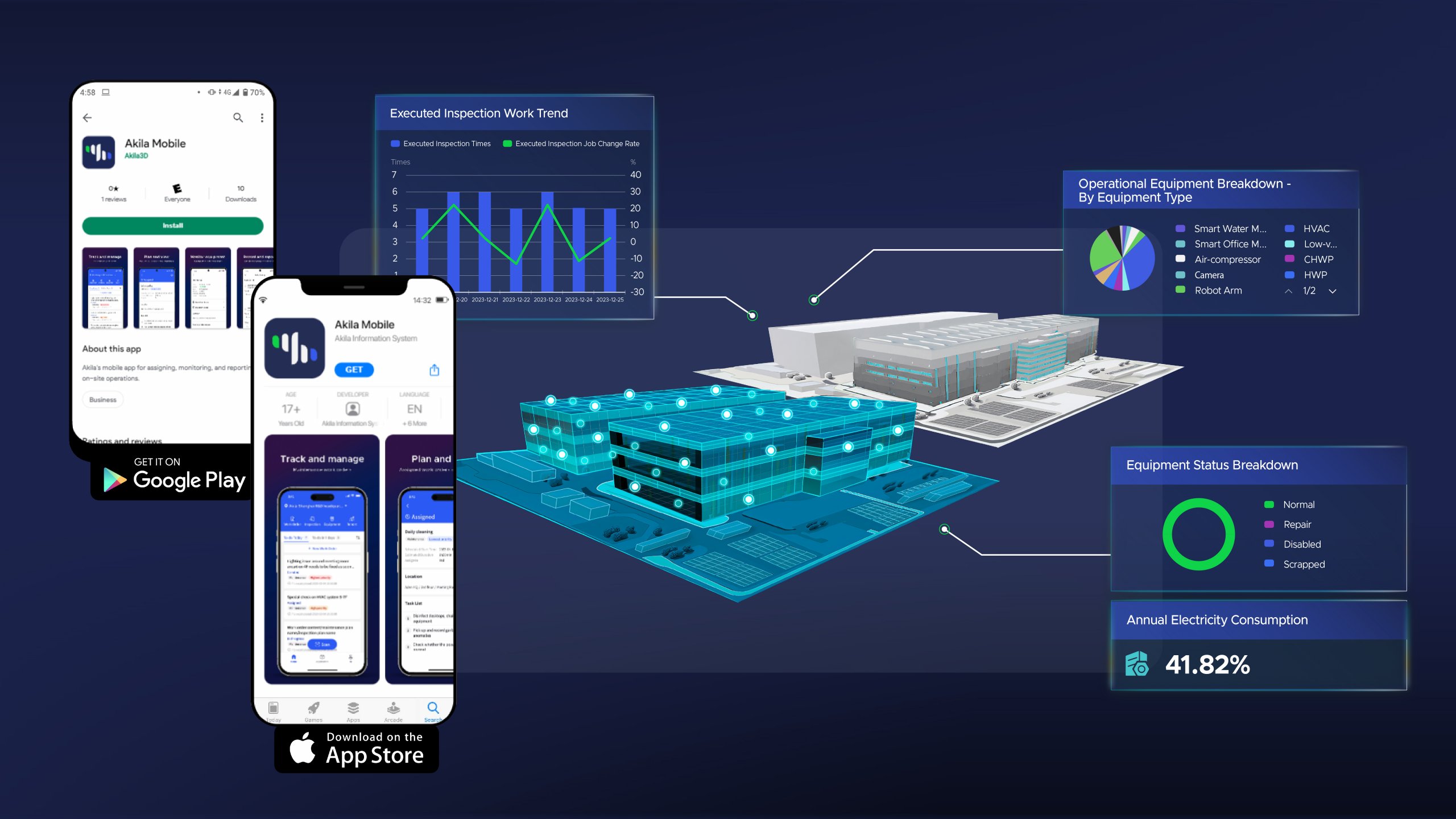
The built environment, which encompasses all man-made structures and spaces, is responsible for 40% of global carbon emissions. It’s an issue that rightly has been receiving lots of attention. Local governments, venture capitalists, and tech startups are all racing to reduce the carbon footprint of buildings. Much of this focus, however, has been on operational carbon emissions since those account for about 27% of that. But what about the remaining 13%? That comes from embodied carbon.
Embodied carbon is a carbon footprint measurement of buildings unique from operational carbon. Embodied carbon refers to the total carbon emissions associated with the production, transportation, and construction of building materials or assets.
What contributes to embodied carbon in buildings?
Embodied carbon in the built environment is a result of various factors, such as building materials, construction processes, transportation, upgrades, renovations, and demolition. It can be seen throughout the entire lifecycle of a building.
In the first phase, the production stage, materials such as concrete, steel, and glass are some of the most significant contributors. The production of these materials requires significant amounts of energy and resources, including fossil fuels, which contribute to greenhouse gas emissions. Transportation also plays a role in embodied carbon, as building materials and equipment are often transported over long distances, adding to their carbon footprint.
During the construction stage, processes such as excavation, site preparation, and assembly of components contribute as well. These processes require significant amounts of energy, provided by electricity, gas, and diesel.
In the operational stage, renovations, and retrofits with new equipment, will add to the embodied carbon of a building. For example, the installation or replacement of building components means more carbon is created in the production and transportation of those components.
Even after years of use, the embodied carbon doesn’t go away. At the end-of-life stage, a building continues to have a carbon impact while it is deconstructed or demolished. This process relies on heavy equipment that burns diesel, requires waste disposal, and will need a fair amount of transportation.

Environmental impacts
Reducing embodied carbon matters for several very important reasons. The production and transportation of building materials and construction have environmental impacts (biodiversity, habitat destruction), contribute to resource depletion of non-renewable materials, and impact climate change in the form of emissions. Managing these materials and processes is a critical strategy for mitigating these impacts.
There are two steps that organizations can take to start acting. First, they must understand how to properly measure embodied carbon. Then, they need to know how to act. Both steps can be made much easier with the help of digital twins.
How to measure and reduce embodied carbon
Measuring embodied carbon is the first step towards acting to reduce it. There are several standards and frameworks that have been developed to measure embodied carbon, including the International Organization for Standardization (ISO) 14044, BREEAM, the Carbon Leadership Forum Life Cycle Assessment (LCA), the RICS method, and several others.
The process of measurement involves gathering data on the materials and products used in a building, calculating the carbon emissions associated with their production and transportation, and combining these values to determine the building’s total embodied carbon. Without the proper documentation or tools, this process is complex and time-consuming. This data provides critical information for making informed decisions about the environmental impact of building materials and construction methods.
That is for projects that haven’t even been built yet. For new buildings, it can be even more challenging. However, the principles of measurement are the same for both new and existing buildings. In both instances, digital twin technology can make the process much more transparent and provide the trackability needed to measure or simulate performance outcomes.
Carbon life cycle management with digital twins
Digital twins like Akila can help measure embodied carbon in the built environment by providing a platform for data collection, analysis, and optimization. One of the most effective applications of digital twins comes prior to building construction, where they can be used to support life cycle assessment (LCA), which considers the environmental impact of a building over its entire lifespan. By integrating LCA into the design and construction process, building owners and operators can make more informed decisions about building materials and construction methods, ultimately reducing the embodied carbon of the building.
For existing projects, digital twins can capture detailed information about building components and systems, including materials, product specifications, and installation details. This data often comes directly from the manufacturer itself and can be connected with digital assets inside of libraries used to create the digital models. Paired with construction project details, digital twins can provide a full picture of embodied carbon for existing sites.
Reducing embodied carbon with digital twins
The data in digital twins can be leveraged to reduce embodied carbon. By monitoring and analyzing real-time data from digital twins, building owners and operators can optimize building performance and selection of materials. For example, digital twins can help identify opportunities to retrofit or upgrade building systems to improve energy efficiency and reduce the carbon footprint of the building. Digital twins can also simulate the environmental impact of different construction scenarios, helping to identify opportunities for improvement.
Depending on which stage your site is at, digital twins can help in the following ways:
- Collaboration: Digital twins can facilitate collaboration between stakeholders involved in building design, construction, and operation. By providing a platform for data sharing and analysis, digital twins can help ensure that all parties are aligned on reducing embodied carbon.
- Monitoring: Digital twins can collect real-time data on building performance, energy consumption, and carbon emissions. This information can be used to identify areas where energy consumption can be reduced, and carbon emissions can be minimized. By continuously monitoring building performance, building owners and operators can make data-driven decisions to reduce embodied carbon.
- Optimization: Digital twins can simulate different scenarios and test the environmental impact of building materials and construction methods. By optimizing building systems and components, digital twins can help reduce the embodied carbon of a building. For example, a digital twin can help identify opportunities to use low-carbon materials or to optimize building systems for energy efficiency.
- Retrofitting: Digital twins can help identify opportunities to retrofit or upgrade building systems and components to reduce embodied carbon. By simulating the environmental impact of different retrofit scenarios, building owners and operators can make informed decisions about how to reduce the carbon footprint of their buildings.
When talking about the carbon impact of the built environment, it is important to look at it holistically – not just the operations, but also the embodied carbon. Knowing how to measure, and having the right tools to help, can empower decision-makers to reduce their building’s carbon footprint. Digital twins are one of the most powerful technologies to do so.
Akila can help optimize building systems, monitor building performance, identify retrofit opportunities, and facilitate collaboration between stakeholders. By leveraging digital twin technology to reduce embodied carbon, building owners and operators can minimize the environmental impact of their buildings and contribute to a more sustainable future.


